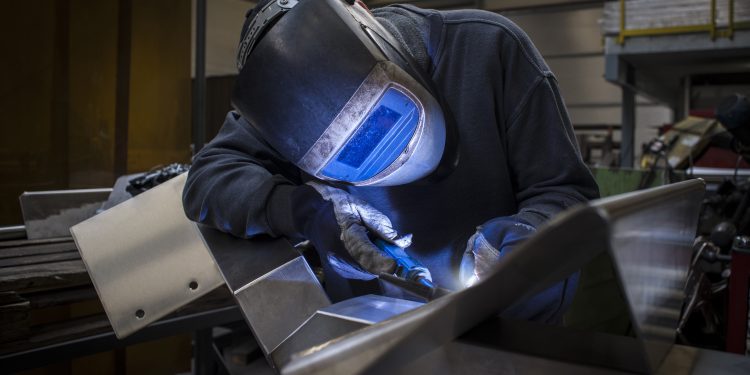The aerospace industry relies heavily on sheet metal fabrication techniques to supply vital parts for everything from aircraft to spacecraft. The problems of tomorrow must be tackled by sheet metal manufacturing methods as the aerospace industry expands and changes.
Several important variables need to be taken into account if custom metal fabrication for aerospace is to meet future challenges. Among these are improvements in materials, rising efficiency and sustainability standards, and the necessity for accuracy and precision in every step of the production process.
Sheet Metal Fabrication Processes for Aerospace Industry
The aerospace industry’s sheet metal production procedures are essential. Wings, fuselages, and engine pieces, among other structures and components, are produced using these procedures. The following are a few of the primary sheet metal fabrication techniques applied in the aerospace sector:
Cutting
Cutting is a crucial step in sheet metal manufacturing because it gives the pieces their basic shapes. In the aerospace sector, laser, water jet, and plasma cutting are the most frequently utilized cutting techniques. While the sector is reliant on sheet metal cutting, it also places considerable importance on tube laser cutting. These techniques are picked according on the precision needed, the thickness and type of metal being used.
Forming
The metal is formed to take on the required shape. In the aerospace sector, a number of techniques are employed, including deep drawing, deep rolling, stamping, and bending. These techniques are picked depending on the intricacy of the item, the level of precision required, and the metal type being used.
Welding
The joining of two or more metal parts is accomplished through welding. MIG, TIG, and resistance welding are just a few of the welding methods used in the aerospace sector. These techniques are picked depending on the kind of metal being used, the required level of joint strength, and the needs of manufacturing.
Surface Treatment
Preparing the metal surface for painting, bonding, or other treatments is known as surface treatment. The aircraft industry employs a number of surface treatment techniques, such as passivation, chromate conversion coating, and anodizing. Depending on the type of metal being used and the desired finish, several techniques are used.
Assembly
Putting everything together to form the finished product is called assembly. This procedure uses fasteners, adhesives, and other connecting techniques. In the aerospace sector, assembly is crucial since the finished product must adhere to high performance and safety regulations.
Challenges in Sheet Metal Fabrication for Aerospace Industry
Here is how Sheet Metal Fabrication is meeting the challenges of tomorrow for Aerospace industry:
Advancements in Materials
Keeping up with metal aerospace parts developments is one of the main problems sheet metal manufacturing faces in the aerospace industry. The aerospace industry has benefited greatly from the development of new materials like high-strength alloys, composites, and lightweight metals.
To produce the intricate forms and geometries needed for aerospace components from these materials, specific manufacturing procedures are needed. As a result, in order to handle the difficulties of working with new materials, sheet metal production techniques must constantly change.
Aerospace is increasingly putting more emphasis on sustainable materials in addition to developing new ones. This includes creating materials that can be recycled or reused, limiting waste, and reducing the negative effects of production operations on the environment.
Wave springs are innovative mechanical components commonly used in various industries, including aerospace. These compact springs are designed with a unique wave-like structure, which allows them to store and release energy efficiently. The aerospace industry benefits from wave springs due to their lightweight design, which is crucial for aircraft and space applications where reducing weight is a priority. Wave springs are known for their consistent force and precision, providing reliable performance in critical aerospace systems. Additionally, their space-saving properties and ability to work well in limited radial and axial spaces make them highly versatile for diverse aerospace engineering applications. From actuating landing gear to controlling valve assemblies, wave springs play a significant role in enhancing the safety and performance of aerospace technology.
Efficiency and Sustainability
Manufacturers in the very competitive aerospace sector are always looking for methods to cut costs and improve efficiency. Manufacturers are constantly seeking ways to improve productivity, decrease waste, and streamline processes, and sheet metal fabrication is no different.
Robotics and automation are two methods for achieving this. Automation can speed up production and cut costs while enhancing accuracy and quality. Robotics can assist in the handling of materials, lowering the possibility of worker damage.
Another crucial factor is sustainability, since many aircraft industries work to minimize their negative effects on the environment. This entails cutting back on waste, utilizing energy-saving techniques, and employing as few hazardous substances and materials as possible.
Precision and Accuracy
Aerospace parts must adhere to stringent precision and accuracy requirements, necessitating a high level of fabrication competence and skill. This is especially true for intricate geometries and precise tolerances, which call for specialized tools and procedures.
One illustration of this is CNC machining, which produces precise and accurate parts using computer-controlled machinery. Aerospace sheet metal manufacturing has been transformed by this technology, which enables producers to produce intricate parts with precise tolerances in a fraction of the time it would take using conventional techniques.
Another illustration is laser cutting, which employs a strong laser to precisely cut through materials. Laser cutting is a flexible tool for aircraft producers since it can be used on a number of materials, such as metals and composites.
Meeting the Challenges of Tomorrow
Manufacturers need to be ready to make investments in R&D, stay current with market trends and innovations, and continuously improve their processes if they want to tackle the challenges of the future in sheet metal fabrication for aerospace.
Increasing productivity and sustainability, this involves accepting new materials and technology like automation and composites. Additionally, it involves making an investment in the training and equipment their team needs to produce precise and accurate components.
Finally, it entails working with suppliers and partners in the sector to find fresh chances and answers for sheet metal fabrication in aerospace. Together, manufacturers can meet today’s difficulties while advancing innovation and the expansion of this dynamic sector.
Conclusion
The aerospace industry relies heavily on sheet metal fabrication to produce the parts required for airplanes and spacecraft. Manufacturers need to be ready to adopt new materials, technologies, and production methods that boost productivity, sustainability, and accuracy if they want to tackle the challenges of the future.
It will take specialized manufacturing techniques to produce complicated geometries and tight tolerances as a result of material advancements, such as the creation of new metals and composites. Robotics and automation will boost productivity, eliminate waste, and streamline production processes. Furthermore, accuracy and precision will continue to be crucial, requiring trained personnel and specialized tools.







